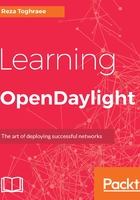
OpenDaylight
OpenDaylight started in early 2013, and it was originally led by IBM and Cisco. It was a new collaborative open source project. OpenDaylight is hosted under Linux Foundation and it draws support and interest from many developers and adopters. OpenDaylight is a platform to provide common foundations and a robust array of services for SDN environments. OpenDaylight uses a controller model that supports OpenFlow as well as other southbound protocols. It is the first open source controller capable of employing non-OpenFlow proprietary control protocols, which eventually lets OpenDaylight to integrate with modern and multi-vendor networks.
The first release of OpenDaylight was in February 2014 with the code name Hydrogen, followed by Helium in September 2014. The Helium release was significant because it marked a change in direction for the platform that has influenced the way subsequent controllers have been architected. The main change was in the service abstraction layer, which is the part of the controller platform that resides just above the southbound protocols, such as OpenFlow, isolating them from the northbound side and where the applications reside.
Hydrogen used an API-driven Service Abstraction Layer (AD-SAL), which had limitations, specifically it meant the controller needed to know about every type of device in the network AND have an inventory of drivers to support them.
Helium introduced a Model-driven service abstraction layer (MD-SAL), which meant the controller didn't have to account for all the types of equipment installed in the network, allowing it to manage a wide range of hardware and southbound protocols.
The Helium release made the framework much more agile and adaptable to changes in the applications; an application could now request changes to the model, which would be received by the abstraction layer and forwarded to the network devices.
The OpenDaylight platform built on this advancement in its third release, Lithium, was introduced in June of 2015. This release focused on broadening the programmability of the network, enabling organizations to create their own service architectures to deliver dynamic network services in a cloud environment, and craft intent-based policies.
The Lithium release was worked on by more than 400 individuals, and contributions from Big Switch Networks, Cisco, Ericsson, HP, NEC, and so on, making it one of the fastest growing open source projects ever. The fourth release, Beryllium, came out in February of 2016 and the most recent fifth release, Boron, was released in September 2016.
Many vendors have built and developed commercial SDN controller solutions based on OpenDaylight. Each product has enhanced or added features to OpenDaylight to have some differentiating factor. The use of OpenDaylight in different vendor products are:
- A base, but also sell a commercial version with additional proprietary functionality-for example: Brocade, Ericsson, Ciena, and so on
- Part of their infrastructure in their Network as a Service (or XaaS) offerings-for example: Telstra, IBM, and so on
- Elements for use in their solution-for example: ConteXtream (now part of HP)
Open Networking Operating System (ONOS), which was open sourced in December 2014, is focused on serving the needs of service providers. It is not as widely adopted as OpenDaylight; ONOS has been finding success and gaining momentum around WAN use cases. ONOS is backed by numerous organizations including AT&T, Cisco, Fujitsu, Ericsson, Ciena, Huawei, NTT, SK Telecom, NEC, and Intel, many of whom are also participants in and supporters of OpenDaylight.
Apart from open source SDN controllers, there are many commercial, proprietary controllers available on the market. Products such as VMware NSX, Cisco APIC, Big Switch Big Cloud Fabric, HP VAN, and NEC ProgrammableFlow are examples of commercial and proprietary products.
The following table lists the commercially available controllers and their relationship to OpenDaylight:
